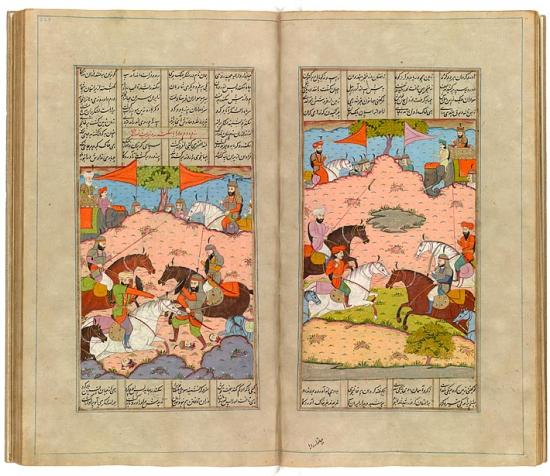
The Armies of Iskandar and Dārā Battle
Shāhnāma (Book of Kings), in Persian
Purchased by Pierpont Morgan, 1909
Iskandar (Alexander the Great) was regarded as a great hero; his stories appear in several works, such as Firdausī's Shāhnāma (Book of Kings), the Persian national epic, and Niẓāmī's Khamsa. Firdausī wrote the epic—in some 50,000 couplets—between 980 and 1010. Shown here are the first two battles between the armies of Iskandar and Dārā (Darius), those at Issus (333 B.C.) and Gaugamela (331 B.C.) Both were won by Iskandar. Lahore flourished under the Mughals, but when this manuscript was made it was the capital city of the Sikhs, who were much indebted to Mughal culture.
Persian poetry
The Persians loved their poetry and their poets, though the Qur˒an warned against believing their words (sura 69.41) and "those straying in evil who follow them" (sura 26.224). While Arabic was the first language of Islam and the language of the Qur˒an, Persian was favored by poets. Even Firdausī's (940–1020) celebrated Shāhnāma (Book of Kings), the national epic of Persian, was written in verse—some 50,000 couplets! Rūmī (1207–1273), the best known of the Sufi poets, put poetry in perspective when he wrote, "A hundred thousand books of poetry existed / Before the word of the illiterate [Prophet] they were put to shame!" (Masnavī I, 529). Presented here are illustrations of Firdausī's Shāhnāma as well as works by Sa˓ dī (ca.1184–1292), Hāfiz (ca. 1320–1389), and Jāmī (1414–1492), regarded as the last of the great Sufi poets. Also featured are illustrations from each of the five poems of the Khamsa (Quintet), by Niẓāmī (ca. 1141–1209), especially Lailā and Majnūn (The Persian Romeo and Juliet) and Bahrām Gūr's Seven Princesses.
